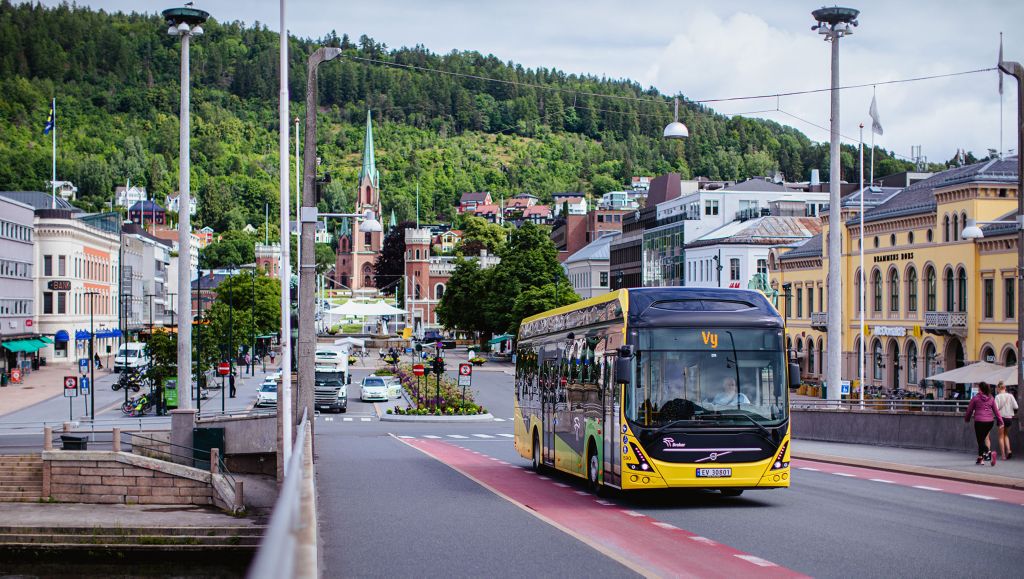Charging ahead in Norway: Bus company Vy gears up for its electromobility journey


The PTAs in Norway are under increasing pressure to meet tough environmental targets
“Volvo Buses has been with us from the start of our electromobility journey, but we have also purchased their diesel buses and have had a close collaboration with them for decades. Our relationship with Volvo Buses is strong – we believe in the quality of the product and the strength of their dealer and workshop network in Norway is highly valued by us. Volvo has also adapted well to our requirements, providing all maintenance work on their buses as part of the partnership,” says Ole Engebret Haugen.
So far, the implementation of electric buses in Drammen has been seamless. The in-depot charging infrastructure is in place and feedback on the buses has been very positive. The drivers like how quiet and smooth they are to drive, and the technical staff and local management have been pleased with how the operation is running.
There are some wider challenges ahead though, says Ole Engebret Haugen. Norway is one of the world’s leaders when it comes to sustainable solutions in its cities. By 2025, one of its environmental goals is for all new buses in city traffic to have zero emissions. The introduction of more electric buses is crucial if the nation is to meet this objective.
“The PTAs in Norway are under increasing pressure to meet tough environmental targets. For example, Oslo’s aim is to be emission free by 2028 and Ruter, the PTA, is working hard towards that goal. Many of the PTA’s we work with demand electric buses, but the transition requires funding. Luckily in Drammen some funding was available, but it’s not always that straightforward,” he explains.
Before a bus tender is submitted, dialogue meetings between PTA’s and PTO’s are arranged.
“Collaboration is key to our success. But although we can incorporate our wishes and views on how we can work towards zero emissions in the dialogue with the PTA’s, it is the PTA that ultimately determines the requirements of the tender,” says Ole Engebret Haugen.
We’re learning and developing very quickly to deliver smart, safe, accessible and green mobility solutions that get people out of their cars and onto our buses.
Another challenge is that all the parties involved are having to adapt to new technology that is still evolving. Responsibility also needs to be taken for adequate charging infrastructure.
“Everyone needs to learn and understand electric buses – not just how they work but also what they require. And that takes time and effort,” he says.
Nonetheless, Ole Engebret Haugen has a positive outlook for the future of electric buses.
“We’re learning and developing very quickly to deliver smart, safe, accessible and green mobility solutions that get people out of their cars and onto our buses. Our electromobility journey has come incredibly far since the days of running one electric minibus in Trondheim all those years ago. It’s a fascinating transition towards a more sustainable future that I am proud to be a part of.”
Established: 1925
Number of employees: Ca. 7,700 in Norway and Sweden
Total number of buses: Ca. 3,000
Total electric buses in operation: 65, including 6 Volvo 7900E’s in Drammen, Norway. By summer 2021 this will increase to 150, 70 of which will be Volvo Buses.
Volvo electric buses on order: 20 x 7900E and 2 x 7900EA to be delivered to Drammen in autumn 2020. A further 10 x 7900E will start operation in Ålesund in January 2021. In Jönköping, Sweden, 48 x 7900EA will be on the road in June 2021.
Customer base: Mainly PTAs in Scandinavia including Ruter, Kolumbus and Innlandstrafikk.
Umbrella company: Vy Buss AB is a part of Vy Group, one of the largest transport operators in Scandinavia. Its business areas also include freight transport, rail passenger services and mobility & tourism.